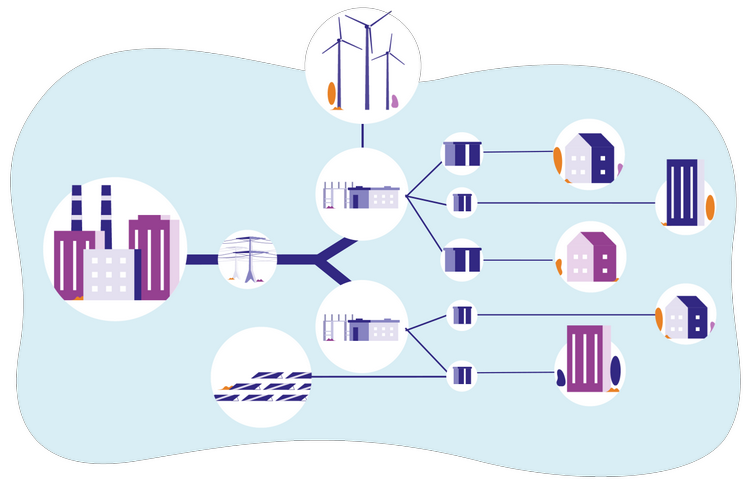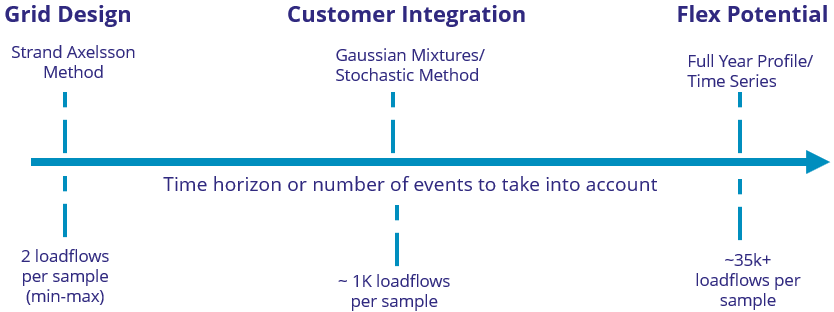Power Grid Model is a high-performance Python/C++ library for steady-state distribution power system analysis.
The global energy transition is placing new and unprecedented demands on Distribution System Operators (DSOs) and grid providers. Alongside upgrades to grid capacity, processes such as digitization, capacity optimization, and congestion management are becoming vital for delivering reliable services.
Power Grid Model provides a calculation engine that is increasingly essential for operators in this new environment. It offers a standards-based foundation enabling real-time power systems analysis, simulations of electrical power grids, and sophisticated what-if analysis. In addition, it enables in-depth studies and analysis of the electrical power grid’s behavior and performance. This comprehensive model incorporates essential factors such as power generation capacity, electrical losses, voltage levels, power flows, and system stability.

Power Grid Model is currently being applied in a wide variety of use cases, including grid planning, expansion, reliability, and congestion studies. It can also help in analyzing the impact of renewable energy integration, assessing the effects of disturbances or faults, and developing strategies for grid control and optimization.
Power Grid Model offers an independent open technology base that speeds and simplifies development of critical Power System technologies for DSO’s and related organizations.
Power Grid Model Benefits
Open Source Business Benefits
- Reduced project time and cost leveraging with field-proven Open Source components
- Rapid, relevant and ongoing innovation through open, community-driven development
- Shared community learning and best practice
Technical Benefits
- Standards-based speeding development, implementation and integration with broader systems
- Unrivalled performance through efficient C++ implementation, native shared memory multi-threading and support for parallel computing
- Ensured accuracy with integrated unit testing and validation test
- Optimized algorithms to capture the true characteristics of the distribution grid
- Full support of three-phase asymmetric calculation

Image: Power Grid Model – High-Level Concept
Features
- Power system calculation functionalities: power flow, state estimation, short circuit
- Linear methods available
- Symmetric and asymmetric calculation
- High-performance implementation in C++ with native parallelization
- API (Application Programming Interface) in Python and C
- Cross-platform
Open Source Community
Hosted by the Linux Foundation Energy, The Power Grid Model is now a vibrant Open Source project with a diverse, active and growing community, consisting of DSO’s, universities, research institutes and commercial parties.
The project is constantly evolving through a vibrant community-driven development process, with future scope to extend the existing libraries and develop more complete open-source applications. As part of this secure ongoing development, continuous validation is conducted through a CI pipeline in GitHub Actions.
Through the community, field validation of the library has been performed against the Power Grid Model reference models in over 80 test cases.
Collaboration
Integration
Architecture
The project consists of two main libraries: power-grid-model and power-grid-model-io.
power-grid-model
The core power-grid-model library is the main calculation engine, optimized for speed, to support real-time modelling, machine learning and powerful predictive analytics. Written in highly efficient C++, the library also offers native shared-memory multi-threading to enable parallelization in batch calculations.
A choice of C-API (with dynamic shared object) and a user-friendly Python API offers flexibility for developers. While the library runs across platforms including Windows (x64), Linux (x64/arm64), and macOS (x64/arm64), and publishes binary Python packages in official PyPI.
The calculation core is a C++ header only library. This is wrapped by a C-API providing direct access with dynamic shared object support for C-API developers. The C-API is then wrapped into a Python API to provide a more user-friendly option for Python developers.
The calculation core is thoroughly tested by its own unit tests and validation tests. While the model can also be validated on the Python side with the same test data.
More in-depth information on Power Grid Model can be found here: https://power-grid-model.readthedocs.io/en/stable/.
power-grid-model-io
The power-grid-model-io library is a data conversion Python library to speed and simplify integration of Power Grid Model into broader system environments. This handles the conversion between the Power Grid Model format and other common grid data formats, with current support for conversion from Vision and pandapower.
More in-depth information on the data conversion library can be found here: https://power-grid-model-io.readthedocs.io/en/stable.
power-grid-model-ds
The power-grid-model-ds library extends the core Power Grid Model calculation engine with a high-level, Pythonic modelling and simulation interface for data-science applications. It defines a Grid dataclass that manages the consistency of the entire network and enables seamless integration of advanced analyses, such as network topology exploration, path and cycle detection, and connected-component checks, directly within data-science workflows. Built on the same performant C++ core as Power Grid Model, PGM-DS exposes essential power-system calculations (power flow, state estimation, short-circuit) through a lightweight Python API, allowing for large-scale batch simulations and rapid prototyping of grid-optimization algorithms.
Key Features:
- Dual Representations, manages both graph- and array-based views of the network, making it easy to switch between topological analyses (e.g., cycle detection, pathfinding) and vectorized computations.
- High-Performance Simulation, leverages the PGM C++ calculation core via a Python wrapper to run simulation-intensive tasks.
- Data Science Integration, designed for batch experimentation, enabling millions of scenario simulations for grid planning, load-forecasting, and reliability studies over multi-year horizons.
Integration and LF Energy Power Grid Suite
Power Grid Model offers a powerful stand-alone calculation engine. Using power-grid-model-io, it can be easily integrated into any broader systems architecture, with out-of-the-box integration modules for Vision and pandapower.
For organizations looking at building full active congestion management systems, Power Grid Model now forms part of a more comprehensive open source tool suite hosted by LF Energy.
Used together, the suite enables DSOs to create end-to-end smart energy software platforms stretching from capacity forecasting, through advanced modelling and calculation, through to intelligent grid-edge mitigation and the implementation of reactive market pricing for steering supply and demand.
The LF Energy Power Grid Suite also incorporates:
 | OpenSTEF uses machine learning for accurate short term forecasting grid load and generation: based on measurements, weather forecasts, pricing on the energy market and other determining metrics. |
 | Shapeshifter offers a framework and libraries for building Smart Energy trading platforms based on the Universal Flex Trading Protocol (UFTP). |
Power Grid Model Use Cases
- Power Grid Model is used by existing DSOs to generate simulations of different potential grid expansion plans in profile calculations over future decades.
- Monte-Carlo: Local operators are using Power Grid Model to simulate different scenarios for low voltage (LV) grid requirements in the coming decades. Simulations are based on different forecasts for the market penetration of electric vehicles and photovoltaics, and are used to identify potential bottlenecks within LV grids.
- Other current use cases include real-time what-if analysis including impact analysis of component failure and other anomalies on the current grid state.
- Alliander’s Delvi Project Leverages LF Energy Power Grid Model to Direct Overhaul of Low Voltage Grid
Power Grid Model Videos
 19:44
19:44
Keynote: From Prototype to Innersource to Open Source: Lessons from a Power Grid Model Journey - Tony Xiang, Principal Scientist, Alliander N.V. & Jonas van den Bogaard, Open Source Office Lead, Alliander
How does a technical prototype evolve into a thriving open source project? In this session, we’ll take you behind the scenes of the Power Grid Model project — a journey that began as a small internal proof of concept and matured through innersource collaboration into a fully open source initiative.
We’ll share key lessons learned along the way, including:
• How innersource practices helped scale adoption and development internally
• The challenges and benefits of transitioning to open source
• Strategies for governance, community engagement, and product evolution
• Technical and organizational insights that shaped the project’s success
Whether you're starting your own open source journey or scaling an internal tool, this talk offers practical takeaways for developers, architects, and open source advocates alike.
YouTube Video UExLeUZmMUo5WGtwdVN4UGVmZ2Ywd01TVnZMLUI0cTd1LS41Mzk2QTAxMTkzNDk4MDhF
 52:21
52:21
Agenda:
-Welcome
-PGM-DS workshop: Join us for an interactive, hands-on session where you'll solve a real-world problem using the PGM-DS project. This session is designed to showcase the versatility and user-friendliness of PGM-DS. You'll work with a realistic use case, utilizing dummy data to explore the full capabilities of the project in a practical, engaging way.
-“Let’s contribute” hackathon: Join us for an exciting hackathon session where you'll collaborate with the Power Grid Model maintainers to work on new contributions to the project. This hands-on experience will allow you to directly impact the development of PGM, as you tackle real challenges and make meaningful contributions alongside experts in the field.
About Power Grid Model
The global energy transition is placing new and unprecedented demands on Distribution System Operators (DSOs). Alongside upgrades to grid capacity, processes such as digitization, capacity optimization, and congestion management are becoming vital for delivering reliable services.
Power Grid Model is an open source project from Linux Foundation Energy and provides a calculation engine that is increasingly essential for DSOs. It offers a standards-based foundation enabling real-time power systems analysis, simulations of electrical power grids, and sophisticated what-if analysis. In addition, it enables in-depth studies and analysis of the electrical power grid’s behavior and performance. This comprehensive model incorporates essential factors such as power generation capacity, electrical losses, voltage levels, power flows, and system stability.
Power Grid Model is currently being applied in a wide variety of use cases, including grid planning, expansion, reliability, and congestion studies. It can also help in analyzing the impact of renewable energy integration, assessing the effects of disturbances or faults, and developing strategies for grid control and optimization.
YouTube Video UExLeUZmMUo5WGtwdVN4UGVmZ2Ywd01TVnZMLUI0cTd1LS45ODRDNTg0QjA4NkFBNkQy
 2:27:25
2:27:25
Agenda:
Presentation 1: CIM/CGMES data import using the generic branch - Udo Schmitz, SOPTIM AG
Presentation 2: Automatic correction of tap-changer positions at distribution transformers using state-estimation and Bayesian Machine Learning - Jacco Heres and Gerrit van Tilburg, Alliander
Keynote: Advanced computation options for power systems - Prof. Peter Palensky, Delft University of Technology
Lightning talks:
-The asymmetric line feature in PGM, utilizing PGM for co-simulations - Leo van Schooten, Eindhoven University of Technology
-Boosting PGMs data science capabilities with the PGM-DS toolkit - Jaap Schouten and Thijs Baaijen, Alliander
-Fast linear loadflows for grid planning - Jasper van Casteren, Tennet
Highlights 2024 - Santiago Figueroa Manrique
Closing
About Power Grid Model
The global energy transition is placing new and unprecedented demands on Distribution System Operators (DSOs). Alongside upgrades to grid capacity, processes such as digitization, capacity optimization, and congestion management are becoming vital for delivering reliable services.
Power Grid Model is an open source project from Linux Foundation Energy and provides a calculation engine that is increasingly essential for DSOs. It offers a standards-based foundation enabling real-time power systems analysis, simulations of electrical power grids, and sophisticated what-if analysis. In addition, it enables in-depth studies and analysis of the electrical power grid’s behavior and performance. This comprehensive model incorporates essential factors such as power generation capacity, electrical losses, voltage levels, power flows, and system stability.
Power Grid Model is currently being applied in a wide variety of use cases, including grid planning, expansion, reliability, and congestion studies. It can also help in analyzing the impact of renewable energy integration, assessing the effects of disturbances or faults, and developing strategies for grid control and optimization.
YouTube Video UExLeUZmMUo5WGtwdVN4UGVmZ2Ywd01TVnZMLUI0cTd1LS5EMEEwRUY5M0RDRTU3NDJC
 20:28
20:28
This video was originally posted at https://fosdem.org/2025/schedule/event/fosdem-2025-4662-empowering-the-energy-transition-through-fast-and-flexible-network-simulation/ and is provided by FOSDEM under the Creative Commons Attribution 2.0 Belgium Licence. To view a copy of this licence, visit http://creativecommons.org/licenses/by/2.0/be/deed.en
Abstract:
Join us for a insightful presentation on the open source "Power Grid Model DS" project, an innovative extension designed to harness the power-grid-model core for advanced data science applications. This session will delve into the project's new modeling and simulation interface, which facilitates efficient grid calculations and utilizes graph algorithms for detailed network analysis. Discover the extended numpy model that enriches development ease and the practical simulation tools for network mutations, underscored by robust debugging capabilities like intuitive network visualization. This discussion is essential for those interested in cutting-edge solutions for smarter, sustainable energy systems.
Building on the foundational strengths of the open-source "Power Grid Model," this library is pivotal in addressing the challenges within the electricity grid, such as the integration of renewable energy sources and smart technologies. Through its C++ core and Python API, it offers advanced features like state estimation, power flow, and short-circuit calculations, crucial for both current applications and academic research. This presentation will highlight how the new open source "Power Grid Model DS" project extends these capabilities, enhancing both immediate operational needs and long-term strategic planning in energy networks, fostering the smart energy transition.
Speakers:
Jaap Schouten, Alliander
Thijs Baaijen, Alliander
YouTube Video UExLeUZmMUo5WGtwdVN4UGVmZ2Ywd01TVnZMLUI0cTd1LS40NzZCMERDMjVEN0RFRThB
 1:3:47
1:3:47
In this January 2025 webinar, the LF Energy Power Grid Model community explored:
-why Alliander started Power Grid Model and how it grew
-how it's currently used outside Alliander
-the community's ambitions for the future
About Power Grid Model
The global energy transition is placing new and unprecedented demands on Distribution System Operators (DSOs). Alongside upgrades to grid capacity, processes such as digitization, capacity optimization, and congestion management are becoming vital for delivering reliable services.
Power Grid Model is an open source project from Linux Foundation Energy and provides a calculation engine that is increasingly essential for DSOs. It offers a standards-based foundation enabling real-time power systems analysis, simulations of electrical power grids, and sophisticated what-if analysis. In addition, it enables in-depth studies and analysis of the electrical power grid’s behavior and performance. This comprehensive model incorporates essential factors such as power generation capacity, electrical losses, voltage levels, power flows, and system stability.
Power Grid Model is currently being applied in a wide variety of use cases, including grid planning, expansion, reliability, and congestion studies. It can also help in analyzing the impact of renewable energy integration, assessing the effects of disturbances or faults, and developing strategies for grid control and optimization.
Full Agenda
- Welcome and Introduction - Peter Salemink
- Part 1: Power Grid Model Origins: The Case for In-House Investment in Distribution Power System Calculations - Werner van Westering
- Part 2: Professionalizing Power Grid Calculations with the Power Grid Model - Tony Xiang
- Part 3: Alliander's Strategic Commitment to Open Source and the Power Grid Model Journey to open source - Jonas van den Bogaard
- Part 4: Scaling Up the Application of the Power Grid Model at Alliander - Jaap Schouten
- Part 5: Using Power Grid Model for research at Eindhoven University of Technology - Nikolaos Paterakis
- Part 6: Future Vision for Power Grid Model - Tony Xiang
- Closing - Peter Salemink
Learn More
Power Grid Model Website: https://lfenergy.org/projects/power-grid-model/
Join the mailing list: https://lists.lfenergy.org/g/powergridmodel
YouTube Video UExLeUZmMUo5WGtwdVN4UGVmZ2Ywd01TVnZMLUI0cTd1LS5GNjNDRDREMDQxOThCMDQ2
 2:26:12
2:26:12
5th Power Grid Model Meet-up
Power Grid Model
The global energy transition is placing new and unprecedented demands on Distribution System Operators (DSOs). Alongside upgrades to grid capacity, processes such as digitization, capacity optimization, and congestion management are becoming vital for delivering reliable services.
Power Grid Model is an open source project from Linux Foundation Energy and provides a calculation engine that is increasingly essential for DSOs. It offers a standards-based foundation enabling real-time power systems analysis, simulations of electrical power grids, and sophisticated what-if analysis. In addition, it enables in-depth studies and analysis of the electrical power grid’s behavior and performance. This comprehensive model incorporates essential factors such as power generation capacity, electrical losses, voltage levels, power flows, and system stability.
Power Grid Model is currently being applied in a wide variety of use cases, including grid planning, expansion, reliability, and congestion studies. It can also help in analyzing the impact of renewable energy integration, assessing the effects of disturbances or faults, and developing strategies for grid control and optimization.
This meetup included:
-Insightful presentations covering two practical applications of the Power Grid Model.
-An update on the latest advancements in Power Grid Model technology during the first and second quarters of 2024.
-An interactive brainstorming session to discuss and propose new feature requests.
Agenda (UTC+2)
13:30 Opening
13:40 Welcome Address: Intelligent Energy Systems Research at TU/e and the Role of Systems Simulation (prof. Koen Kok, TU/e)
14:10 Network calculations for enhanced capacity management in distribution networks (Irena Dukovska, Alliander)
14:40 Coffee break
15:10 Optimising Reactive Power Flow in Medium Voltage Networks (Niels Dirks, Enexis)
15:40 Highlights Q1/Q2 2024 + Community announcements + brainstorm/planning
16:20 Closing
YouTube Video UExLeUZmMUo5WGtwdVN4UGVmZ2Ywd01TVnZMLUI0cTd1LS5DQUNERDQ2NkIzRUQxNTY1
Recent Power Grid Model News
Upcoming Meetings
View the meeting calendar
View the calendar of all LF Energy events
Project Special Interest Group: Grid Simulation and Modeling
Project Lifecycle Stage: Incubation











).
The session includes key design insights, practical use cases, and a short live demo showcasing how CGMES-based models can be used directly in PGM for grid analysis.](https://lfenergy.org/wp-content/plugins/youtube-feed-pro/img/placeholder.png)








Lightning Talk: Integrating CGMES-Based Grid Models Using the Generic Branch in Power... Udo Schmitz
September 22, 2025 2:40 pm